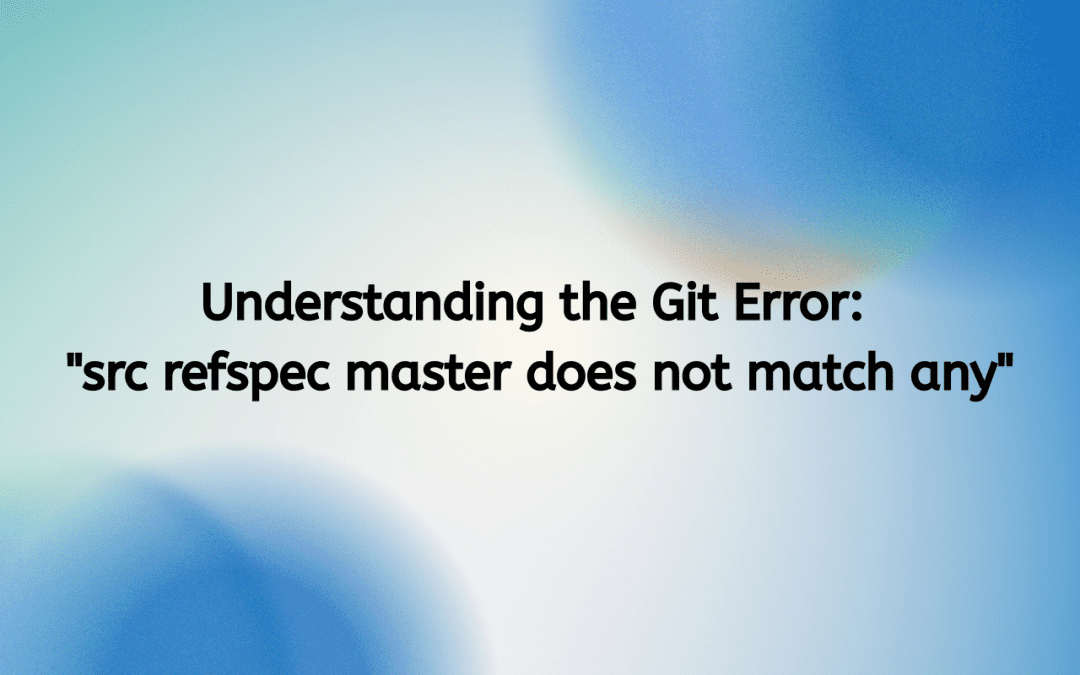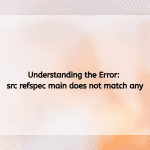As a developer, working with version control systems like Git is an essential part of the workflow. However, encountering errors can disrupt your progress and lead to frustration. One common error that many developers face is the message:
error: src refspec master does not match any.
In this article, we will explore this error in detail, including its causes, implications, and how to resolve it effectively.
What Does the Error Mean?
The error message src refspec master does not match any typically occurs when you try to push changes to a remote repository or perform other Git operations involving the master branch (or any branch name). Essentially, it indicates that Git cannot find the specified branch or reference in your local repository.
Breakdown of the Error Message
- src refspec: This part refers to the source reference specification you are trying to use. In the context of Git, it typically refers to branches.
- master: This is the name of the branch you are trying to reference. The default branch in many Git repositories is often named
master, but newer repositories may usemainor other names. - does not match any: This indicates that Git cannot find a branch or reference matching the specified name.
Common Causes of the Error
Understanding the underlying causes of the error can help you diagnose and fix it more effectively. Here are some common scenarios that lead to this issue:
1. No Commits in the Repository
If you have just initialized a new Git repository using git init but haven’t made any commits yet, there won’t be any branches available. Consequently, trying to push to the master branch will result in this error.
2. Incorrect Branch Name
Another common reason for this error is a typo or incorrect branch name. If you are trying to push to a branch that doesn’t exist in your local repository, Git will throw this error.
3. Empty Local Repository
If your local repository is empty and you attempt to push to a remote branch, Git will not find any references to match, resulting in the error message.
4. Detached HEAD State
If your repository is in a detached HEAD state, you might be referencing a commit instead of a branch. This could lead to the src refspec error when trying to push changes.
5. Misconfigured Remote Repository
If the remote repository is not set up correctly or if the remote branch does not exist, you may encounter this error when pushing changes.
How to Resolve the Error
Now that we have identified the common causes of the error, let’s discuss how to resolve it effectively.
1. Ensure You Have Made Commits
If your repository is newly initialized and you haven’t made any commits, you can create an initial commit by following these steps:
git add .
git commit -m "Initial commit"
This will create a new commit in your local repository, allowing you to push to the master branch (or whichever branch you are targeting).
2. Check Your Branch Name
Make sure you are referencing the correct branch name. You can check your current branch by running:
git branch
If you discover that your branch is named differently (like main instead of master), you can switch to the correct branch or push to the right branch name:
git push origin main
3. Confirm the Remote Repository Setup
Verify that your remote repository is configured correctly. You can check your remotes with:
git remote -v
If the remote repository is not set up, you can add it using:
git remote add origin <repository-url>
4. Create and Switch to the Desired Branch
If you are trying to push to a branch that doesn’t exist yet, you can create and switch to that branch
git checkout -b master
Then, make your commits before attempting to push again.
5. Resolve Detached HEAD State
If you find that you are in a detached HEAD state, you can create a new branch from your current commit and push that instead:
git checkout -b new-branch
git push origin new-branch
6. Pushing to the Correct Remote Branch
If you are trying to push changes to a remote branch that does not exist, you can create it by using the -u flag to set the upstream branch:
git push -u origin master
This command will create the master branch on the remote repository if it doesn’t exist and set your local branch to track it.
Best Practices to Avoid the Error
To minimize the chances of encountering the src refspec master does not match any error in the future, consider the following best practices:
1. Regularly Commit Changes
Make it a habit to commit your changes regularly. This not only helps in maintaining a clean history but also ensures that you have a valid branch to push.
2. Verify Branch Names
Always double-check your branch names before performing Git operations. Using commands like git branch can help confirm your current branch.
3. Maintain a Clean Remote Setup
Regularly review and maintain your remote repository configuration. This includes verifying that the correct remote URLs are set up and that branches exist where expected.
4. Use Descriptive Branch Names
When creating new branches, use descriptive names that indicate their purpose. This practice helps avoid confusion and makes it easier to manage multiple branches.
5. Document Your Workflow
If you are working in a team, document your Git workflow clearly. This includes branch naming conventions, commit message guidelines, and branch management practices.
Conclusion
The src refspec master does not match any error is a common obstacle encountered by developers when working with Git. Understanding its causes and how to resolve it is essential for maintaining an efficient and productive workflow.
By ensuring that your repository has commits, verifying branch names, and maintaining a clean remote setup, you can minimize the chances of encountering this error in the future. Embrace best practices in your Git workflow, and you will find that version control becomes a smoother and more manageable aspect of your development process.
Whether you’re a seasoned developer or just starting, mastering Git will undoubtedly enhance your ability to collaborate and manage your code effectively. Happy coding!

Hello everyone! We’re Galussothemes content team, we love to write new blogs for WordPress Joomla! and other tech niches everyday. We’re talented young people who hold a strong passion for website development, designing, and marketing. Feel free to leave your comment if you have any issues or questions with our blogs.












